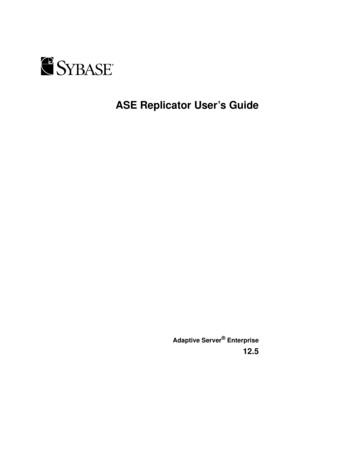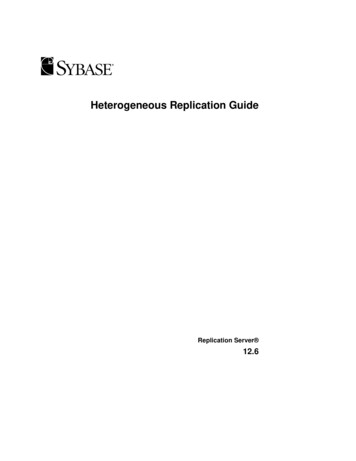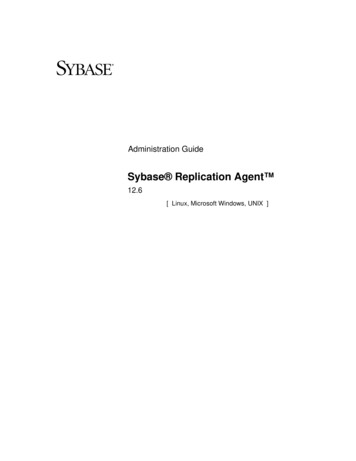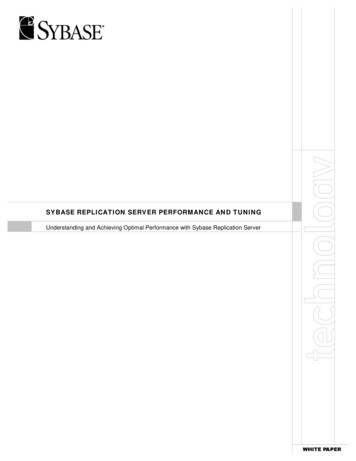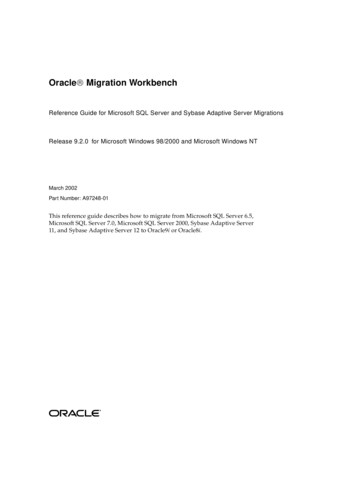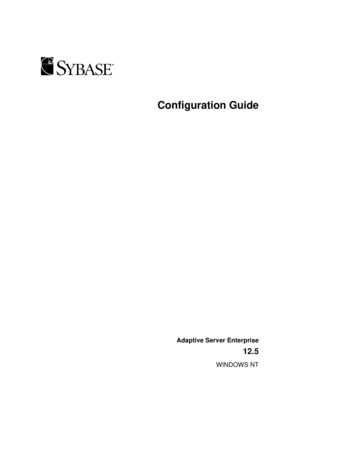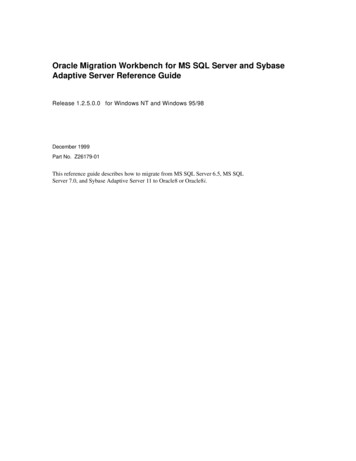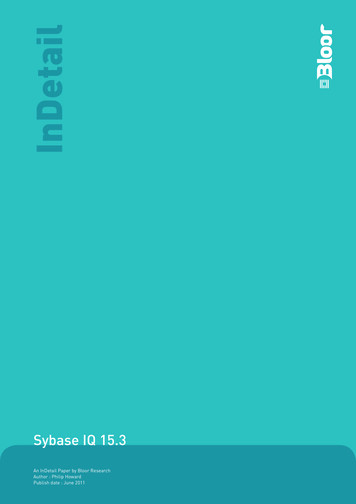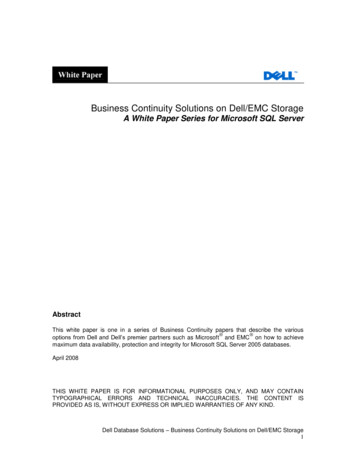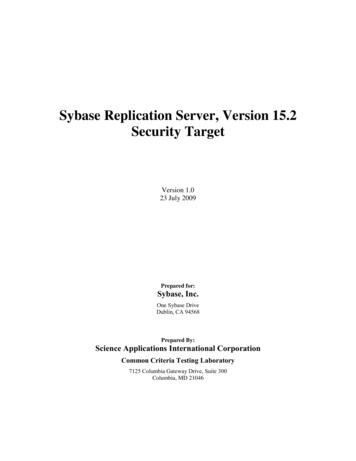
Transcription
Sybase Replication Server, Version 15.2Security TargetVersion 1.023 July 2009Prepared for:Sybase, Inc.One Sybase DriveDublin, CA 94568Prepared By:Science Applications International CorporationCommon Criteria Testing Laboratory7125 Columbia Gateway Drive, Suite 300Columbia, MD 21046
Security TargetVersion 1.0, 07/23/091. SECURITY TARGET INTRODUCTION .41.11.21.32.SECURITY TARGET, TOE AND CC IDENTIFICATION .4CONFORMANCE CLAIMS .4CONVENTIONS .4TOE DESCRIPTION .52.1TOE OVERVIEW .52.2TOE ARCHITECTURE .52.2.1Physical Boundaries .82.2.2Logical Boundaries .92.3TOE DOCUMENTATION .93.SECURITY ENVIRONMENT . 103.13.24.SECURITY OBJECTIVES . 114.14.24.35.THREATS . 10ASSUMPTIONS . 10SECURITY OBJECTIVES FOR THE TOE. 11SECURITY OBJECTIVES FOR THE IT ENVIRONMENT . 11SECURITY OBJECTIVES FOR THE ENVIRONMENT. 11IT SECURITY REQUIREMENTS . 125.1TOE SECURITY FUNCTIONAL REQUIREMENTS . 125.1.1User data protection (FDP) . 125.1.2Identification and authentication (FIA) . 135.1.3Security management (FMT) . 135.2IT ENVIRONMENT SECURITY FUNCTIONAL REQUIREMENTS . 145.2.1User data protection (FDP) . 145.2.2Protection of the TSF (FPT) . 145.3TOE SECURITY ASSURANCE REQUIREMENTS. 145.3.1Configuration management (ACM) . 155.3.2Delivery and operation (ADO) . 155.3.3Development (ADV) . 155.3.4Guidance documents (AGD) . 165.3.5Tests (ATE) . 175.3.6Vulnerability assessment (AVA) . 186.TOE SUMMARY SPECIFICATION . 196.1TOE SECURITY FUNCTIONS. 196.1.1User data protection . 196.1.2Identification and authentication . 196.1.3Security management . 206.2TOE SECURITY ASSURANCE MEASURES . 206.2.1Configuration management . 206.2.2Delivery and operation . 206.2.3Development . 216.2.4Guidance documents . 216.2.5Tests . 216.2.6Vulnerability assessment . 227.PROTECTION PROFILE CLAIMS . 238.RATIONALE . 248.1SECURITY OBJECTIVES RATIONALE. 242
Security TargetVersion 1.0, 07/23/098.1.1Security Objectives Rationale for the TOE and Environment . 248.2SECURITY REQUIREMENTS RATIONALE . 268.2.1Security Functional Requirements Rationale. 268.3SECURITY ASSURANCE REQUIREMENTS RATIONALE . 278.4STRENGTH OF FUNCTIONS RATIONALE . 278.5REQUIREMENT DEPENDENCY RATIONALE . 278.6EXPLICITLY STATED REQUIREMENTS RATIONALE. 288.7TOE SUMMARY SPECIFICATION RATIONALE. 288.8PP CLAIMS RATIONALE . 29LIST OF TABLESTable 1 TOE Security Functional Components . 12Table 2 TOE Security Management Roles . 13Table 3 IT Environment Security Functional Components . 14Table 4 EAL 2 Assurance Components . 15Table 5 Environment to Objective Correspondence . 24Table 6 Objective to Requirement Correspondence . 26Table 7 Security Functions vs. Requirements Mapping . 293
Security TargetVersion 1.0, 07/23/091. Security Target IntroductionThis section identifies the Security Target (ST) and Target of Evaluation (TOE) identification, ST conventions, STconformance claims, and the ST organization. The TOE is Sybase Replication Server (SRS) provided by Sybase,Inc. The SRS is designed to replicate data in multiple databases in order to provide database clients local accesseven to data that would otherwise be remote.The Security Target contains the following additional sections:TOE Description (Section 2)Security Environment (Section 3)Security Objectives (Section 4)IT Security Requirements (Section 5)TOE Summary Specification (Section 6)Protection Profile Claims (Section 7)Rationale (Section 8).1.1 Security Target, TOE and CC IdentificationST Title – Sybase Replication Server Security TargetST Version – Version 1.0ST Date – 23 July 2009TOE Identification – Sybase Replication Server, version 15.2TOE Developer – Sybase, Inc.Evaluation Sponsor – Sybase, Inc.CC Identification – Common Criteria for Information Technology Security Evaluation, Version 2.3, August 20051.2 Conformance ClaimsThis TOE is conformant to the following CC specifications:Common Criteria for Information Technology Security Evaluation Part 2: Security FunctionalRequirements, Version 2.3, August 2005.Part 2 ConformantCommon Criteria for Information Technology Security Evaluation Part 3: Security AssuranceRequirements, Version 2.3, August 2005.Part 3 ConformantAssurance Level: EAL 2Strength of Function Claim: SOF-basic1.3 ConventionsThe following conventions have been applied in this document:4
Security TargetVersion 1.0, 07/23/09Security Functional Requirements – Part 2 of the CC defines the approved set of operations that may beapplied to functional requirements: iteration, assignment, selection, and refinement.oIteration: allows a component to be used more than once with varying operations. In the ST,iteration is indicated by a letter placed at the end of the component. For example FDP ACC.1aand FDP ACC.1b indicate that the ST includes two iterations of the FDP ACC.1 requirement, aand b.oAssignment: allows the specification of an identified parameter. Assignments are indicated usingbold and are surrounded by brackets (e.g., [assignment]). Note that an assignment within aselection would be identified in italics and with embedded bold brackets (e.g., [[selectedassignment]]).oSelection: allows the specification of one or more elements from a list. Selections are indicatedusing bold italics and are surrounded by brackets (e.g., [selection]).oRefinement: allows the addition of details. Refinements are indicated using bold, for additions,and strike-through, for deletions (e.g., “ all objects ” or “ some things ”). Note thatdeletions are indicated only when not replaced with an addition.Other sections of the ST – Other sections of the ST use bolding to highlight text of special interest, such ascaptions.2. TOE DescriptionThe Target of Evaluation (TOE) is Sybase Replication Server (SRS), version 15.2.2.1 TOE OverviewSRS maintains replicated data in multiple databases and provides clients using databases in the replication systemwith local data access, thereby reducing load on the network and centralized computer systems. The SRS has thefollowing features:A Replication Command Language (RCL) enables replication functions to be managed and monitoring andmaintenance of the replication system.SRS supports heterogeneous data servers.SRS uses a basic publish-and-subscribe model for replicating data across networks.SRSs communicate with each other via user-defined routes.2.2 TOE ArchitectureSRS is an Open Server application. SRS uses the Sybase Open Client/Server (OC/S) for network communicationand other platform dependent functions, such as connection management, login protocol, data transmission, T-SQLinterface, inter-process communication, etc. SRS uses operating system services for process creation andmanipulation, device and file processing, memory management and security requests such as inter-processcommunication, albeit indirectly through the OC/S. The hardware upon which the operating system runs istransparent to SRS which sees only the operating system’s user interfaces.SRS maintains replicated data in multiple databases. Data in the replicate database is ‘loosely consistent’ with thedata in the primary database, lagging behind primary data by the amount of time it takes to distribute updates fromthe primary to the replicate databases. Note that the notion of primary data server is data dependent. At any giventime, all data servers known to SRS could be the primary for some data that they host.5
Security TargetVersion 1.0, 07/23/09As indicated above, the SRS uses a basic publish and subscribe model for replicating data across networks. Users‘publish’ data in a primary database, and other users ‘subscribe’ to the data for delivery into a replicate database.Changes to both data and stored procedures can be replicated. Instructions to publish and subscribe to data are givenat replication servers that control or have a connection to each database. Users create replication definitions at theprimary Replication Server, which controls the primary database with the data to be published. The user creates asubscription at the replicate Replication Server, which controls the replicate database that will receive theinformation.Connections and routes define the structure of the replication system. A connection conveys messages from a SRSto a database. A route transfers requests from a source SRS to a destination SRS.SRS distributes database operations from a primary database to a destination SRS, using the Log Transfer Language(LTL1), as functions that consist of a name and a set of data parameters. The destination SRS then uses functionstrings to map functions to the commands recognized by the destination SRS. These commands may be transactioncontrol directives such as begin transaction or commit transaction, or data manipulation instructions such as insert,update or delete. Function strings are categorized into function string classes based on the type of replicate dataserver.SRS depends on data servers to provide the transaction-processing services needed to protect stored data. Dataservers must comply with the following conventions:A transaction is one unit of work – either all operations in the transaction are performed, or none areperformed.Transactions results are permanent. A transaction cannot be undone after it is committed.RSSDRSSDPrimaryReplicationServerPrimary DataServerReplicateData nsactionsTransactionsLDAP ServerLDAP ServerStable QueuesStable QueuesOther replicateReplicationServersFigure 1: Replication System Overview1LTL is the language Replication Server uses to process and distribute replicated transactions and procedureinvocations throughout a replication system.6
Security TargetVersion 1.0, 07/23/09SRS configuration data is stored in an instance of Sybase Adaptive Server Enterprise (ASE) database called theReplication Server System Database (RSSD) or an instance of SQL Anywhere database called the EmbeddedReplication Server System Database (ERSSD). Note that Sybase ASE is not included in the TOE, but rather isrequired to be configured in the environment to support the TOE. Note that ERSSD is not part of this evaluation.Note also that it is expected that the RSSD/ERSSD would be configured such that only SRS can access and modifyits own configuration data. The data in these tables are modified only internally within the SRS, and only the SRSAdministrator can alter the system tables.DestinationData ry DataServerLTL(Log act SQLDSIDestinationReplicationServerFigure 2: Replication Server InternalsSRS uses a disk partition to establish stable queues. During replication operations, updated data is temporarilystored in these queues. There are 3 types of queues:Inbound Queue – holds messages only from a Replication Agent for primary data. A Replication Agentscans the database transaction log and sends transaction information to the Replication Server fordistribution to subscribing databases.Outbound Queue – holds messages for a replicate database or a replicate SRS. For each replicate databasemanaged by a SRS, there is a Data Server Interface (DSI) outbound queue. For every SRS to which a SRShas a route, there is a Replication Server Interface (RSI) outbound queue.Subscription materialization queue – holds messages related to newly dropped or created subscriptions.SRS has several threads that manage different specific tasks. Below are some of the SRS threads and functions:Reads and writes to each queue are managed by a Stable Queue Manager (SQM) thread.Connection with the data server is managed by a DSI thread. The DSI thread executes the transactions inthe replicate database in the correct commit order.Connection with each destination SRS is managed by an RSI thread. RSI threads send messages from oneSRS to another when a route exists between them.Client applications are programs that access the data server. In a simple replication system, clients update primarydatabases and the SRS updates the replicate databases. However, SRS allows replication rules to be createdallowing data updated at a replicate data server to be reflected back on the primary and other replicate servers.7
Security TargetVersion 1.0, 07/23/09Support for Sybase Adaptive Server Enterprise data servers is provided via an associated Replication Agent shippedwith the SRS. Interfacing with other data servers can be done by providing applications (i.e., additional ReplicationAgents) that interface with the SRS and the foreign data server 2. Existing databases and applications need not beconverted to build the replication system.SRS manages login names, passwords and permissions (associated with roles) that are essential for system security.SRS login names and specific permissions are required for:Each component of the replication system, such as the RSSDs, Replication Agents, Replication Servers,data servers, etc.Each user who is setting up replicated data or is monitoring and managing the SRS.Users require specific permissions to perform specific Replication Command Language (RCL) commands.Encrypted passwords are supported throughout the system, but are not evaluated because they are not required tosatisfy the security objectives of the TOE. Replication Server uses Sybase Common Security Infrastructure (CSI) toprovide server or client authentication, cryptography for encryption and decryption of passwords that are stored inthe RSSD tables, and key-pair generation to support extended password encryption. CSI is an Open Client / Serverfeature, which is utilized by linking Replication Server with OCS provided CSI (Common Security Infrastructure)libraries. FIPS 140-2 (certificate #542 Security Builder FIPS module from Certicom Security Builder GSE Version2.0) applies to cryptographic function to support the following function: AES algorithm with 128-bit encryption keyis used to encrypt passwords that are stored in the RSSD. In addition, Security Builder GSE Version 2.2 fromCerticom is used to support extended password encryption (RSA public and private cryptography algorithm). Inaddition, Certicom SSL Plus 5.2.2 and Certicom Security Builder GSE 2.0 are used to support SSL SRS alsosupports third party security services such as Kerberos and DCE that ensure secure message transmission over thenetwork, and enable user authentication for login to SRSs in the replication system. Note that such third partycapabilities are not addressed in this evaluation. Isql interface to Replication Server also supports network baseduser authentication with –V option. With this option, the user must log in to the network's security system beforerunning the utility. Replication Server version 12 and later supports MIT Kerberos version 5 or later, CyberSafeKerberos version 5 Security Server, and Transarc DCE version 1.1 Security Server. Note that these third-partysoftwares are not part of TOE. However, they can be used in Replication Server’s IT environment to providenetwork-based security. Replication Server secure sockets layer (SSL) Advanced Security option provides sessionbased security. SSL is the standard for securing the transmission of sensitive information, such as credit cardnumbers and stock trades, over the Internet. Note that SSL is a third-party software and is not part of TOE.However, it can be used in Replication Server’s IT environment to provide session-based security.SRS uses LDAP server which provides global directory services for sharing component information such as servernames and connection properties. LDAP is a third party software and Replication Server only uses Open Client/Open Server libraries interface to use this service. LDAP is not part of the TOE. LDAP should be considered acomponent of the IT environment which can be used to provide global directory services.2.2.1 Physical BoundariesThe TOE itself consists of the Sybase Replication Server (SRS), version 15.2 product. The TOE configurationincludes one or more SRS products configured as a replication system and attached to various data servers (e.g.,Sybase Adaptive Server Enterprise).SRS operates on any of the following operating systems: Sun Sparc 32 (version 8, 9, 10, 32 bit & 64 bit), Sun X64(version 10, 32 bit & 64 bit), HP Itanium (version 11.23, 11.31, 64 bit), Microsoft Windows (2003 SP2, XP, Vista,Longhorn, 32 bit & 64 bit), IBM AIX (version 5.3, 32 bit & 64 bit), IBM P-Series (RHEL 4.4, SuSE SLES 10, 64bit), and Linux X86 (RHEL 4.4, RHEL 5.0, SuSE SLES 10, 32 bit & 64 bit).SRS also utilizes services of the Sybase Open Client/Server (OCS), Version 15.2 product as indicated previously aswell as an instance of Sybase ASE.Note that the TOE relies on the underlying OS for protection and on OC/S to secure network communications.2Note that while additional Replication Agents can be developed for other data servers and can interface with theTOE using LTL, for the purpose of testing only the Sybase ASE Replication Agent is being considered.8
Security TargetVersion 1.0, 07/23/092.2.2 Logical BoundariesThis section summarizes the security functions provided by SRS:- User data protection- Identification and authentication- Security management2.2.2.1 User data protectionSRS controls the flow of information among associated data sources. An authorized administrator can defineprimary data sources, replicate data sources, and the replication routes that will be used to replicate data throughoutthe replication system represented by one or more SRS products working in concert.2.2.2.2 Identification and authenticationSRS maintains login information for its own access to other components so it can perform its functions, but alsorequires users and other components to be identified and authenticated prior to offering any of its services. Users arerequired to login before they can manage aspects of the replication system and other components must be identifiedand authenticated before SRS will interact (e.g., accept or provide data) with that other component.2.2.2.3 Security managementSRS restricts its own management functions by requiring users to be logged in before they can access securitymanagement functions. Users are associated with a set of roles defined within SRS and once logged in the functionsavailable to the user are restricted based on their associated role. While SRS supports multiple roles for its ownmanagement for the purposes of this ST, they are treated abstractly as an authorized administrator due to thesubstantial overlap in authority. In general, SRS provides functions to monitor and manage the replication of datathroughout the replication system.2.3 TOE DocumentationSybase offers a series of documents that describe the installation of SRS as well as guidance for subsequent use andadministration of the applicable security features (see section 6.2 for details).9
Security TargetVersion 1.0, 07/23/093. Security EnvironmentThe TOE security environment describes the security aspects of the intended environment in which the TOE is to beused and the manner in which it is expected to be employed. The statement of the TOE security environment definesthe following:- Threats that the TOE and the environment of the TOE counters and- Assumptions made about the operational environment and the intended method of use for the TOE.Furthermore, the TOE is intended to be used in environments where the relative assurance that its security functionsare enforced is commensurate with EAL 2 as defined in the CC.3.1 ThreatsT.MISROUTEData being replicated from between primary and secondary data sources may be misdirectedby an unauthorized user.T.SECURREPData being replicated from a primary to a secondary data source may be subject tounauthorized disclosure or modification.3.2 AssumptionsA.NETWORKIt is assumed that the environment protects network communication media appropriately.A.NO EVILAuthorized administrators are non-hostile, appropriately trained and follow all administratorguidance.A.NO GENERAL PURPOSEThere are no general-purpose computing capabilities (e.g., compilers or user applications)available on replication servers, other than those services necessary for the operation,administration and support of the replication server.A.PHYSICALIt is assumed that appropriate physical security is provided within the domain for the value ofthe IT assets protected by the TOE and the value of the stored, processed, and transmittedinformation.A.ROBUST ENVIRONMENTIt is assumed that the IT environment provides support commensurate with the expectations ofthe TOE.10
Security TargetVersion 1.0, 07/23/094. Security ObjectivesThis section defines the security objectives for the TOE and its supporting environment. The security objectives areintended to counter identified threats and address applicable assumptions.4.1 Security Objectives for the TOEO.AUTHUSER The TOE must ensure that only authorized users can control the flow of replicated data within theTOE.O.INFOFLOWThe TOE must ensure that replicated data flows within the TOE in accordance with definedinformation flow rules.4.2 Security Objectives for the IT EnvironmentOE.PROTECTThe IT environment must ensure that the TOE and its means of communication are protected fromtampering and disclosure.4.3 Security Objectives for the EnvironmentOE.CONFIGThe TOE will be installed, configured, managed and maintained in accordance with its guidancedocumentation and applicable security policies and procedures by appropriately trained andtrusted administrator personnel.OE.NETWORK The environment must protect network traffic to and from the TOE from unauthorized disclosure.OE.NO GENERAL PURPOSEThere will be no general-purpose computing capabilities (e.g., compilers or user applications)available on DBMS servers, other than those services necessary for the operation, administrationand support of the DBMS.OE.PHYSICAL Physical security will be provided within the domain for the value of the IT assets protected by theTOE and the value of the stored, processed, and transmitted information.OE.TRUST ITEach IT entity the TOE relies on for security functions will be installed, configured, managed,maintained and provide the applicable security functions in a manner appropriate to the IT entity,and consistent with the security policy of the TOE and the relationship between them.11
Security TargetVersion 1.0, 07/23/095. IT Security RequirementsThe security requirements for the TOE have all been drawn from Parts 2 and 3 of the Common Criteria. The securityfunctional requirements have been selected to correspond to the actual security functions implemented by the TOEwhile the assurance requirements have been selected to offer a low to moderate degree of assurance that thosesecurity functions are properly realized by users of the TOE.5.1 TOE Security Functional RequirementsThe following table describes the SFRs that are candidates to be satisfied by Replication Server.Requirement ClassFDP: User data protectionFIA: Identification and authenticationFMT: Security managementRequirement Component
The TOE is Sybase Replication Server (SRS) provided by Sybase, Inc. The SRS is designed to replicate data in multiple databases in order to provide database clients local access even to data that would otherwise be remote. The Security Target contains the following additional sections:
